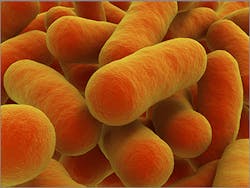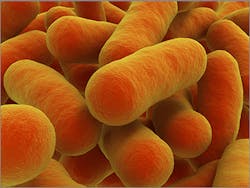New biosensors give off fluorescence to manage engineered bacteria effectively
Researchers at the Wyss Institute for Biologically Inspired Engineering at Harvard University (Cambridge, MA) have developed a biosensor that couples fluorescence-emitting proteins and four detectors that respond to the presence of a specific chemical in genetically engineered bacterial cells, such as E. coli. By leveraging their natural metabolic processes, bacteria could be re-programmed to convert readily available sources of natural energy into pharmaceuticals, plastics, and fuel products.
Related: The many approaches and applications of biosensing
Biosensors act as the switches and levers that turn programmed functions on and off inside the engineered cells. They also can be used to detect which microbial workers are producing the most voluminous amounts of a desired chemical. In this way, they can be thought of as the medium for two-way communication between humans and cells.
"The basic idea is that we want to accelerate evolution to make awesome amounts of valuable chemicals," says Wyss Core Faculty member George Church, Ph.D., who is a pioneer in the converging fields of synthetic biology, metabolic engineering, and genetics. Church is the Robert Winthrop Professor of Genetics at Harvard Medical School and Professor of Health Sciences and Technology at Harvard and MIT.
But so far, scientists have only had access to a limited variety of biosensors that have little relevance to the biomanufacturing of valuable chemicals. Now, the researchers—led by Church—have developed a new suite of biosensors that not only increase the number of cellular switches and levers that scientists can use for complex genetic reprogramming, but also respond to valuable products such as renewable plastics or costly pharmaceuticals and give microbes a voice to report on their own efficiency in making these products.
"We can communicate with cells much more effectively, and vice versa," says Jameson Rogers, a graduate researcher at the Wyss Institute who is pursuing his PhD in Engineering Sciences from Harvard University, and first author of the study. "If we compared this to controlling a computer, it’s almost like we have only had the up and down arrows available to us, and now suddenly we have doubled our control capabilities by adding the left and right arrows as well."
The Wyss team aims to leverage the new biosensors to aid in its efforts to develop renewable chemical production strategies using genetically engineered microbes.
Linked to green fluorescent protein (GFP), the biosensors can be used to trigger individual cells to give off visible fluorescence in a rate directly proportional to how well they are able to produce a desired chemical commodity. Using the new biosensors, the most efficient microbial workers are easily identified so that they can serve as the predecessors for colonies of engineered bacteria that evolve to become more efficient at producing renewable chemicals with each subsequent generation. This drastically reduces the bottleneck of the design-build-test cycle, which has historically been caused by engineers having to sift through teeming bacteria colonies to find top producers.
The findings could also lead to new applications in environmental monitoring using genetically engineered microbes to issue warning signals in the presence of pollutants or toxins, and could unlock new fundamental insights into metabolic pathways.
"Our team is developing several different ways to make even more custom biosensors," says Church. "We’re trying to control biological processes and we need new ways to get our hands in at the molecular level—we’re now reaching in deeper than we’ve previously been able to, and we still have many interesting new approaches."
Full details of the work appear in the journal Nucleic Acids Research; for more information, please visit http://dx.doi.org/10.1093/nar/gkv616.
Follow us on Twitter, 'like' us on Facebook, connect with us on Google+, and join our group on LinkedIn

